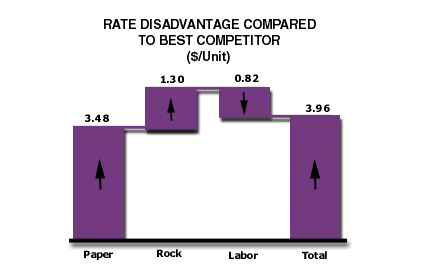Analysis 56: Analysis of Rates of Cost Differential
EXHIBITS:

| HOW TO INTERPRET THE ANALYSIS: The exhibit compares a company to the best competitor in the industry on the rates of cost each company pays for paper, rock and labor. The comparison is expressed on the basis of the impact on the total cost per unit of the rate differences the company pays compared to the low cost competitor. The company has a disadvantage in its cost of paper that cause its total cost per unit to be $3.48 higher than that of the best competitor in the industry. The company also has a disadvantage in its cost to purchase rock. Its disadvantage in the rate of cost it incurs to purchase rock causes a $1.30 disadvantage in total cost per unit of sale compared to the best competitor in the industry. On the other hand, the company enjoys an advantage in the rate it pays for its labor compared to the best competitor in the industry. The lower labor rate the company enjoys enables it to gain an $.82 advantage. When the sum of the cost disadvantages are weighed against the labor rate advantage the company enjoys, the company has a total of $3.96 per unit of sale cost disadvantage compared to the best competitor in the industry.
PURPOSE: This analysis highlights the Company's cost differences compared to competition in the rates of cost paid for Purchases and People. The company would use the results of this analysis to establish targets for its cost reduction efforts. APPROACH: This analysis evaluates the advantages or disadvantages the company faces on rates of costs for people and key purchased commodities. The analysis translates these rate of cost advantages or disadvantages into a cost per unit of sale relative to the best, that is lowest cost, competitor in the marketplace. If the company is the lowest cost competitor, then it compares itself to the next lowest cost competitor. Rates of costs apply to the three Building Block Costs of People, Purchases and Capital. The most important two Building Block Costs to consider are Purchases and People. If the rate of cost of Capital is important for the company, relative to its competition, then the finance function can also evaluate any rate differential that might exist due to Capital costs. This analysis enables the company to gain a partial understanding of its cost position relative to the best competitors in the marketplace. The combination of finance and the operations functions estimate the cost advantage or disadvantage of the company relative to its best competitors by determining the best competitor in each cost category (that is, People and Purchases) and then comparing the Company's costs against those of the best competitor. The company then translates these cost differences into a cost per unit of sale advantage or disadvantage. The company may estimate some of these cost differences by evaluating its own cost changes for items, like critical materials purchased, as the company has grown larger and projecting how those cost differences might compare for companies who are both larger and smaller than the company. Return to Diagnose Costs: Rates of Costs |
|
Recommended Reading |
| For a greater overall perspective on this subject, we recommend the following related items:
Analyses: Symptoms and Implications: Symptoms developing in the market that would suggest the need for this analysis.
Perspectives: Conclusions we have reached as a result of our long-term study and observations.
|
